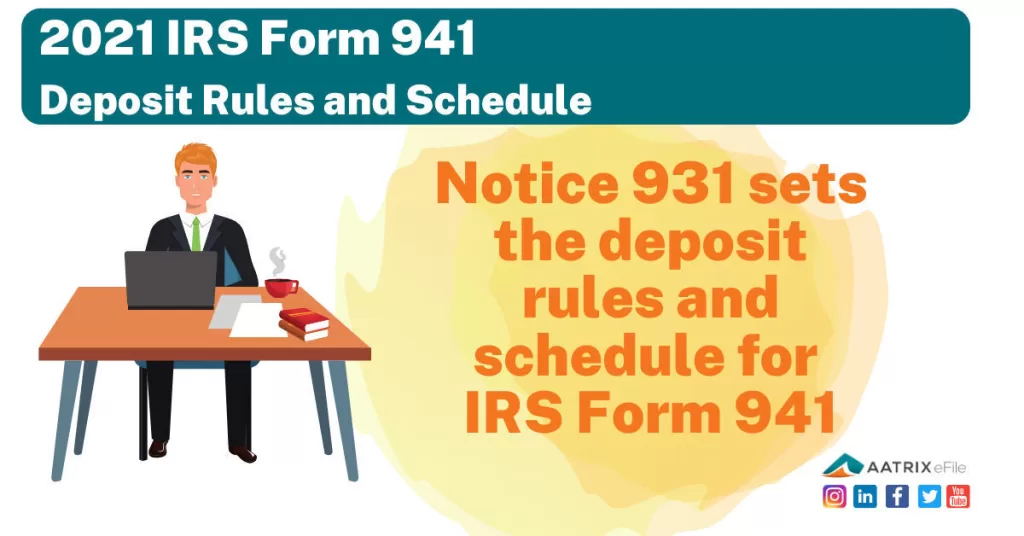
Notice 931 sets the deposit rules and schedule for Form 941
This information is also used for Forms: 943, 944, 945, and CT-1.
Two Deposit Schedules
There are two deposit schedules (monthly or semiweekly) for determining when you deposit social security and Medicare taxes and withheld federal income tax. These schedules tell you when a deposit is due after a tax liability arises (for example, when you have a payday). Before the beginning of each calendar year, you must determine which of the two deposit schedules you must use. The deposit schedule you must use is based on the total tax liability you reported during a look-back period. Your deposit schedule isn’t determined by how often you pay your employees or make deposits.
941 Monthly Deposit Schedule
Your business is a monthly schedule depositor for a calendar year if the total tax reported for your look back period was $50,000 or less. Under the monthly deposit schedule, deposit accumulated taxes on payments made during a calendar month by the 15th day of the following month. New employers. Your tax liability for any quarter in the look back period before the date you started or acquired your business is considered to be zero. Therefore, your business is a monthly schedule depositor for the first calendar year of your business.
941 Semiweekly Deposit Schedule
Your business is a semiweekly schedule depositor for a calendar year if the total taxes during your look back period were more than $50,000. Deposit Period (Payment Days) Deposit By Wednesday, Thursday, and/or Friday Following Wednesday Saturday, Sunday, Monday, and/or Tuesday Following Friday
$100,000 Next-Day Deposit Rule
If you accumulate a tax liability of $100,000 or more on any day during a deposit period, you must deposit the tax by the close of the next business day, whether you’re a monthly or semiweekly schedule depositor.
Deposit rules for annual Forms 943, 944, 945, and CT-1
Generally, the deposit rules for quarterly filers of Form 941 also apply to annual filers of Form 943, Employer’s Annual Federal Tax Return for Agricultural Employees; Form 944, Employer’s ANNUAL Federal Tax Return; Form 945, Annual Return of Withheld Federal Income Tax; and Form CT-1, Employer’s Annual Railroad Retirement Tax Return. However, the period used as your look back period is different.
Federal tax deposits must be made by electronic funds transfer (EFT)
You must use EFT to make all federal tax deposits. Generally, an EFT is made using the Electronic Federal Tax Payment System (EFTPS). You can arrange for your tax professional, financial institution, payroll service, or other trusted third party to make electronic deposits on your behalf. Also, you may arrange for your financial institution to initiate a same-day wire payment on your behalf.
Depositing on time
For EFTPS deposits to be on time, you must submit the deposit by 8 p.m. Eastern time the day before the date the deposit is due. If you fail to submit an EFTPS deposit on time, you may use the same-day wire payment option discussed above.
What Is The Look-back Period?
Look-back period for Form 941.
Your deposit schedule for a calendar year is determined from the total taxes reported on your Forms 941 in a 4-quarter look-back period. The look-back period begins July 1 and ends June 30. If you reported $50,000 or less of Form 941 taxes for the look-back period, you’re a monthly schedule depositor; if you reported more than $50,000, you’re a semiweekly schedule depositor.
Look-back period for annual returns
For annual returns (Forms 943, 944, 945, and CT-1), the look-back period is the calendar year preceding the previous year. For example, the look-back period for 2021 is 2019.
Accuracy of Deposits Rule
You’re required to deposit 100% of your tax liability on or before the deposit due date. However, penalties won’t be applied for depositing less than 100% if both of the following conditions are met.
- Any deposit shortfall doesn’t exceed the greater of $100 or 2% of the amount of taxes otherwise required to be deposited.
- The deposit shortfall is paid or deposited by the shortfall makeup date as described below.
Makeup Date for Deposit Shortfall
Monthly schedule depositor
Deposit or pay the shortfall with your return by the due date of the return. You may pay the shortfall with your return even if the amount is $2,500 or more.
Semiweekly schedule depositor
Deposit by the earlier of: 1. The first Wednesday or Friday that falls on or after the 15th of the month following the month in which the shortfall occurred.
Additional details are available in the 931 Notice.
